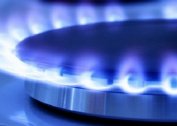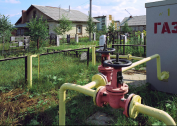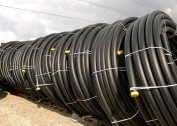Highway - a pipeline designed to transfer gas, oil, water, oil products from the place of production or receipt to the place of consumption. This is a whole complex of structures, including pipes, stations, protection installations, storage tanks and more. The main gas pipeline is a variety that provides transportation of natural gas.
The purpose of the main gas pipeline
Main gas is natural gas produced from fields. The line delivers the blue fuel from the production point or processing site to the final points. This also includes a piping system linking individual gas production sites. All of them constitute the Unified Gas Supply System of the Russian Federation.
The end point of the highway is not a specific consumer, but an enterprise or station. The pipeline through which gas is delivered from the main pipe to the village is called a branch.
The diameter of the main pipes is very large - from 720 to 1420 mm. Blue fuel is transported only under overpressure. For the main gas pipeline, only steel seamless cold-rolled pipes are allowed.
 Lay the system in different ways:
Lay the system in different ways:
- Underground installation is the most profitable. Pipes are laid in trenches to a depth of 0.8 m and 1 m with a diameter of up to 1000 mm and up to 1400 mm, respectively. In marshy and peaty soils, the depth is needed more - 1.1 m, and in rocky soils - 0.6 m less.
- Elevated - the highway is installed on supports, and does not lie on the ground.
- Ground - this option is implemented in bulk dams.
- Underwater - if gas is extracted from the bottom of a reservoir, an underwater gas pipeline is equipped.
The functionality of the main gas pipeline is usually the responsibility of a state-owned company.
Varieties of highways
 The main pipeline is a complex system. It is classified according to various characteristics: the diameter of the pipes used, the pressure under which the blue fuel is transmitted, the laying method, and the system design. The performance and purpose of gas pipelines are different.
The main pipeline is a complex system. It is classified according to various characteristics: the diameter of the pipes used, the pressure under which the blue fuel is transmitted, the laying method, and the system design. The performance and purpose of gas pipelines are different.
Depending on working pressure
The pressure class distinguishes 2 classes of gas transmission lines:
- 1 - working pressure is 2.5–20 MPa. Allowed the transfer of liquefied gas.
- 2 - the pressure value is 1.2–2.5 MPa.
The diameter and wall thickness is determined by the purpose and method of laying the gas pipeline. The pipe material depends on such indicators. For products with a diameter of up to 500 mm, they are made of soft carbon and low-carbon steels, for pipes with a cross-section up to 1020 mm - from calm and semi-quiet low-carbon alloys. Pipes up to 1420 mm in size are made only of low alloy steel.
Depending on destination
 The gas main is being built for various purposes. The size of the design is noticeably different:
The gas main is being built for various purposes. The size of the design is noticeably different:
- Trunk - carry out the transportation of gas over long distances. The system includes pumping units, treatment facilities, gas distribution structures. The highway operates continuously, this is one of the most important conditions.
- Technological - systems serving enterprises. They can transfer natural gas, steam and other gases. They also provide the removal of production waste.
- Utility networks - transport steam. The pressure here is much lower, but the design of such a system is usually complicated.Distinguish between distribution, transit systems and branching.
- Ship - structures for pumping gas on ships.
- Machine - pressure and non-pressure systems for supplying fuel, oil. Their size is small.
Each gas pipeline is marked with a special sign. Marking is numbered by GOST and is included in the trunk complex. On the sign post information about the highway and warnings.
General structure
 The main gas pipeline is not only pipes, but also a variety of equipment that ensures continuous continuous operation:
The main gas pipeline is not only pipes, but also a variety of equipment that ensures continuous continuous operation:
- a branch pipeline equipped with loopings and pressure fittings, as well as all the structures that provide transportation: connection units, structures for overcoming artificial and natural obstacles, start-up and metering units, reception structures for cleaning, reduction points, methanol input devices;
- installation of electrochemical and corrosion protection of steel pipes;
- nodes of technological communication;
- power lines - are installed to control valves, as well as electrochemical protection of the line;
- devices for monitoring the condition of the pipeline at a distance;
- fire fighting equipment;
- design for degassing and storage of condensate;
- tanks for emergency release of liquefied gas;
- constructions and constructions of the service line;
- helipads, roads and signs indicating the location of the gas pipeline;
- underground liquefied hydrocarbon storage stations;
- pumping stations - compressor, bulk, head, pumped, and also tank farms;
- warning signs.
Underground trunking is preferred. The gas pipeline and the oil pipeline can be laid in one technical corridor.
Gas pipeline design
Integrated design involves several stages:
- Geodetic, geological, hydrological and environmental studies throughout the future highway. According to the information received, it is determined how to lay the pipe, where to install the pumps, and whether additional maintenance equipment is required.
- Determination of efficiency and economic benefits: pumping volume, supply zones, final and initial points and intermediate selection points are determined.
- Calculation of the characteristics of the pipeline - pipe diameter, working and maximum pressure, the number of pumping stations.
- Design of reservoirs, distribution stations, transmission and selection nodes, treatment facilities and others.
- Economic feasibility study: construction costs, comparison with other methods of fuel delivery.
The design result is a set of technical documentation, including estimates, calculations, drawings, breadboard models, feasibility studies, notes and other materials needed for construction.
Construction scheme
Different gas laying schemes are used different:
- monofilament - the system is mounted from pipes of the same diameter throughout;
- multi-line - several pipelines are laid in one technical corridor;
- telescopic - the diameter of the pipeline from the initial to the final station varies.
If the laying of the highway includes different structures - an underground circuit, aboveground, underwater - use more complex construction schemes.
Comparison of main gas with a gas tank
 The main line most often means a branch of a gas pipeline with a pressure below 0.005 MPa. For gasification of the house, it is required to design and install an external and internal gas pipeline, connect gas appliances inside the house and connect the circuit to the local gas pipeline.
The main line most often means a branch of a gas pipeline with a pressure below 0.005 MPa. For gasification of the house, it is required to design and install an external and internal gas pipeline, connect gas appliances inside the house and connect the circuit to the local gas pipeline.
Gas holder - a reservoir for storing liquefied gas. A mixture of propane and butane is pumped into a steel container under pressure.The liquefied mixture gradually turns into a gaseous one, being forced into the gas pipeline due to the difference in pressure. The tank is installed on a site near the house, connected by a pipeline to gas appliances in the building. As the fuel is exhausted, gas is periodically pumped.
All work on the installation of the main and gas holder is carried out only by gas service employees.
Both options have their pros and cons:
- Main gas is 98% methane. A mixture of propane and butane is stored in the tank.
- In case of accidents on pipelines, the main gas can be turned off. The gas holder provides autonomy.
- The cost of connecting to the highway on average is 50-100 thousand rubles. The construction of a gas tank and the installation of maintenance equipment costs at least 200 thousand rubles.
- The timing of construction depends on many factors. If there is a gas pipe in the village, the connection is completed in 1-3 days. Documents take longer. But if from the building to the highway more than 200 m, the connection will be delayed for 3-4 months. Installing a gas tank takes 1-3 days.
- Main gas safety is higher. Methane is lighter than air and rises upward when leaking. If the house has normal ventilation, the risk of poisoning or fire is small. The propane-butane mixture is heavier than air and accumulates at the floor level to critical values completely unnoticed.
Due to the risk of leakage, gas holders cannot be placed near wells and basements.
The cost of use is approximately equal. Although methane from the highway costs 3-4 times cheaper, in fact it is consumed much faster. When burning methane, only 9 kW is released, and when burning a propane-butane mixture - 28 kW, therefore, when heating a building of natural gas, you have to burn 3 times more.
Gas pipeline regulations and protection

The rules for the technical operation of highways describe in detail the norms and requirements for the operation of main facilities and equipment. Recommendations for each component of the complex are developed:
- When installing the trunk, you can use only pipes and SDG with certificates.
- Only cleaned and dried gas can be supplied to the pipeline.
- Stop valves are equipped with local and remote control systems.
- Upon contact of the alloy and the earth, the metal undergoes electrochemical corrosion. It significantly reduces the life of the pipeline. To prevent it, install cathodic, tread or drainage protection.
- All work on the inspection, repair and prevention of the main gas pipeline is carried out only by employees of the gas service.
The rules for operation and use of gas pipelines with medium and low pressure are identical. The difference is only the repair methods or laying associated with the pressure.




